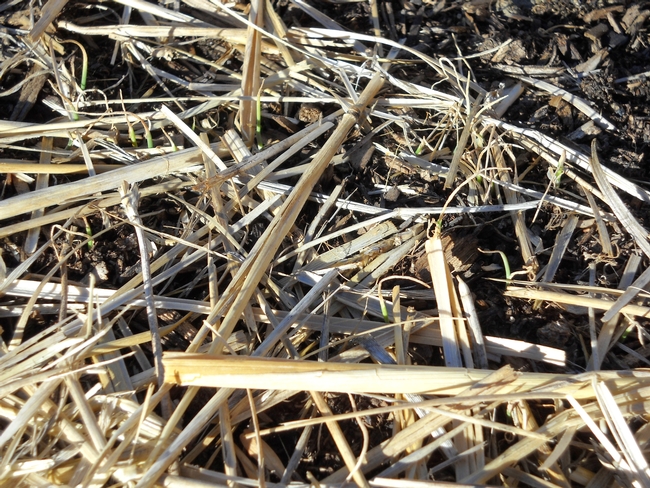Ever since a fellow Master Gardener generously gave me some garlic to plant, assuring me that it was easy, I have been planting garlic every fall. And, she was right about it being easy. For the last 4 years, growing garlic has been the extent of my winter gardening. This year, for some reason, I decided it was time to try overwintering onions, mostly, I think, because I have read that this is the best way to grow Walla Walla Sweet onions – a favorite of mine. So, armed with copious research and three kinds of seeds, I put in onions at the same time I planted my garlic. So, anyone reading this, just know that I am inspired to write this piece not as an expert, but as a newbie to the onion scene and in hopes that others with some experience will chime in.
My garlic bed gets prepared once my sweet corn has been harvested – think late August or early September. That garden plot gets the most winter sun --- an important consideration for both garlic and onions. I amend the soil with compost and chicken manure, turn it deeply to make sure the soil is loose and drains well. Then I form raised beds about one foot wide by six feet long. I chose to direct seed the onions because several of the articles I read mentioned that sweet onions started from seed overwinter better and store better than sets. Also, I have never had much luck with sets and I prefer to direct seed rather than start seeds in flats – quite honestly, never had much luck there either.
The seeds came from a reputable supply catalog, I chose Walla Walla Sweet, Top Keeper (a yellow onion), and Desert Sunrise (a red onion). For overwintering, the recommendation is to purchase varieties that are Short Day or Day Neutral – also called Intermediate. Most sweet onions are short day, meaning that they produce onion bulbs when they receive 11 to 12 hours of daylight. By comparison, long day varieties need 14 to 16 hours of daylight – not enough for winter growing. Intermediate and neutral varieties fall somewhere in between these and will work for our latitude. Bulbing onions depend on day length for bulb production. Once the roots and leaves form, the bulb forms when day and night lengths reach the proper number of hours.
The tiny black seeds are planted no deeper than ¼ of an inch and will germinate in temperatures as chilly as 45 degrees F. Just like garlic, onions don't mind a bit of cold or even frost. I did apply mulch, in the form of straw, to both the garlic and onions. They need to be watered until the ground freezes – then just leave them alone until spring! At least, that's what I read.
So, now I am just waiting and watching. Even though it has been quite cold, the onions have been hanging in there. I can see their green shoots poking through the mulch – not as tall as the garlic, but still green and still there. I do go out and check them pretty much every day, just...because. Anyway, like the garlic, the onions are busy doing their underground thing. In the spring, they will begin to grow in earnest and I plan to thin them to about 6 inches apart, hopefully using the thinnings like scallions. Again, like garlic, when the bulbs are ready to harvest, (probably by May) their leafy tops turn brown and they can be gently pulled and allowed to dry before storage and use. Sweet onions don't store for a long time, which is one reason I planted some other varieties. Also, I plan to eat them pretty quickly because I really enjoy onions and, by May, there should be plenty of other veggies growing to enjoy them with.
Well, that's the adventure so far. I promise to let you know how it goes in the spring. Meanwhile, I hope you enjoy rainbow garden dreams with new seed catalogs – green tomatoes, yellow watermelon, white eggplant, purple carrots, red lettuce and blue corn!
